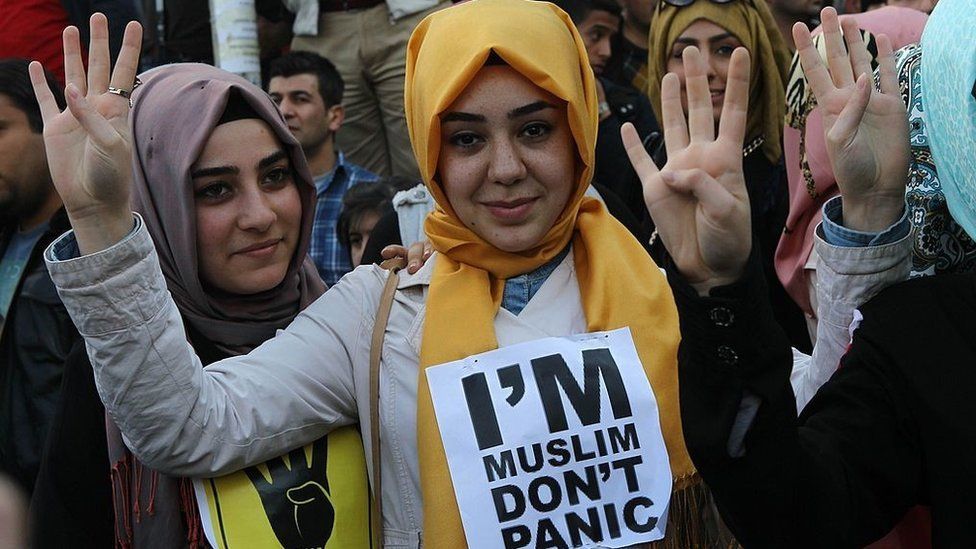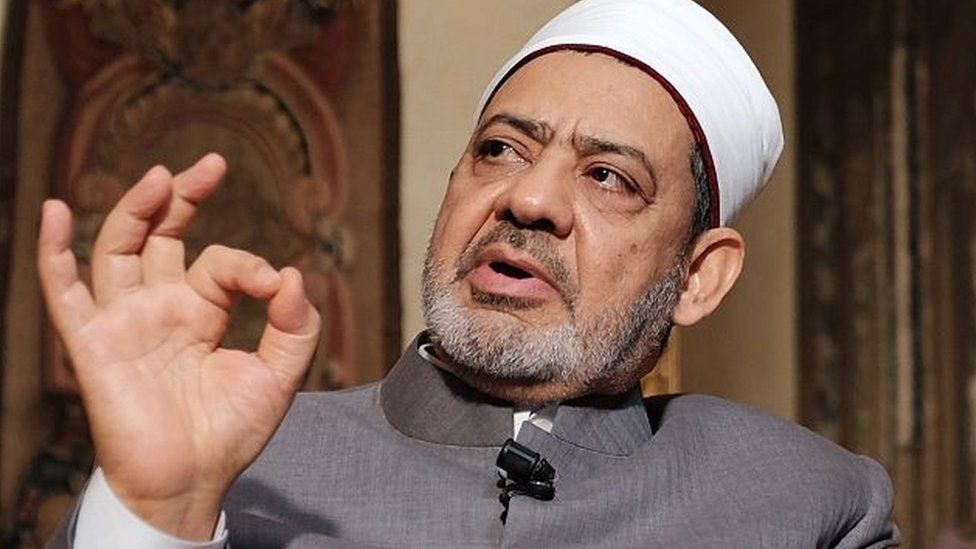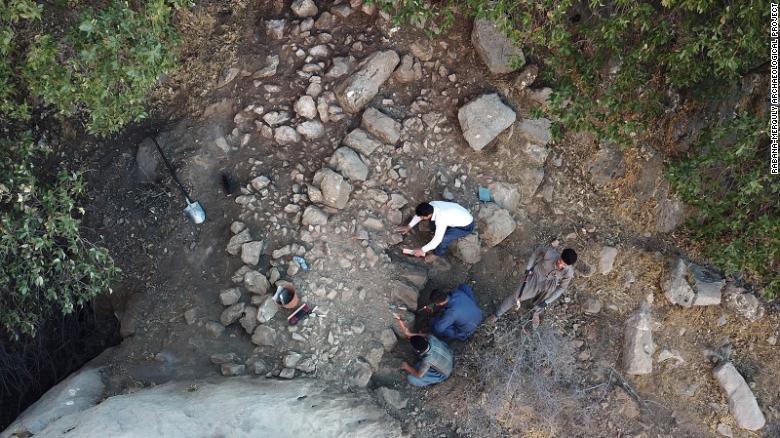Islamic veil: Why fewer women in North Africa are wearing it
By Magdi Abdelhadi
North Africa analyst
 SOCIAL MEDIA
SOCIAL MEDIAPhotos of women in full Islamic attire - faces covered and in long dresses - next to old pictures of women in short skirts from the 1950s and 1960s in North Africa and the Middle East are often put together on social media to make a point.
The underlying message is: "Look what has become of Arab societies during the past 50 years or so."
To those who share such photos, it is the most visible sign of how their countries have regressed and abandoned the ideals of progress and modernity, exemplified by adopting a Western lifestyle.
But for the conservative forces that have shaped the region in the past few decades, it is quite the opposite: it is a positive act of asserting Muslim identity in societies that had for long been colonised and had a Western lifestyle imposed upon them first by colonial rulers, and then by Westernised elites out of touch with local culture.
From Morocco to Egypt and beyond, the issue of "Islamic dress code", in particular the veil or hijab, has been one of the most controversial piece of clothing.
By all accounts, its spread within the region has been down primarily to one factor: the emergence and eventual success of political Islam, the phenomenon also known as Islamism.
The whole of North Africa has powerful Islamist movements that either came to power or nearly did as in the case of Algeria in the early 1990s.
Even after they were removed from power, their influence over societies has remained considerable.
But that is beginning to change, according to many observers. And one of the most obvious ways to assess that is by looking at the most potent symbol of the impact of Islamism: the hijab.
 GETTY IMAGES
GETTY IMAGESMany observers have noted that the past few years have seen a steady decline in the phenomenon in North Africa.
In Moroccan news website Al-Yaoum 24, columnist Said El-Zaghouti recently wrote: "It's not hard to notice that the extent to which the hijab was worn in our Arab world, and in particular in Morocco, has gone down relatively, and that retreat and decline is to a large extent due to the decline and ebb of what is known as the Islamic current."
Young Moroccan women have spoken to local media about the social pressure, even harassment, they have to endure when they take off the hijab. But that has apparently not deterred them.
In Tunisia, where wearing the hijab was once an act of defiance because it was banned by successive autocratic regimes, it became popular for a brief period following the 2011 Arab Spring, but has started to fall off again recently.
Writing in the Arabic Independent, Tunisian journalist Huda Al-Trabulis highlights the complex motives for the appearance of the hijab in the country and its subsequent decline.
The hijab was once an act of resistance and opposition to secularism imposed from above during the rule of the post-independence autocrats, Habib Bourguiba and Zine al-Abidine Ben Ali.
It then became popular in the short period after the revolution in 2011 that saw the rise to power of the Islamist Ennahda movement, to the extent that the veiled woman was promoted as the model to follow for the Tunisian public.
But then it fell out of favour as successive Islamist-dominated parliaments failed to solve the country's many problems and Tunisia plunged into a deep economic and political crisis.
 AFP
AFPIn Egypt too, arguably the birthplace of the hijab as we know it today, the appearance and relative decline is tied up with the political fortunes of the Muslim Brotherhood.
Egyptian women began throwing off traditional face coverings nearly a century ago and by the mid-twentieth century the veil had almost completely disappeared.
But the hijab made its first re-emergence in the mid-seventies when then-President Anwar Sadat gave a green light to the Muslim Brotherhood to operate on university campuses to fight off political rivals from the secular left who had developed considerable influence over society in the previous decades.
The spread of the hijab continued almost unabated until 2013 when the Muslim Brotherhood President Mohammed Morsi was removed from power.
Hostility to Islamist symbols - the hijab foremost amongst them - was palpable.
There were persistent reports of restaurants denying access to women wearing the hijab, or swimming pools refusing entry to women wearing the burkini, the supposedly Sharia-compliant swimsuit.
Today there is palpable decline that is hard to quantify due to a lack of objective surveys. The evidence is largely anecdotal.
Still, the hijab remains one of the country most divisive issues - a cultural and political fault-line not dissimilar to the one surrounding abortion in the US, with cultural and political rows breaking out at regular intervals on the matter.
 GETTY IMAGES
GETTY IMAGESMost recently in Egypt reactions to the stabbing to death of a young university student in broad daylight by her suitor after she refused to marry him were as shocking as the crime itself.
To everyone the crime was abhorrent and duly condemned. But as soon as it emerged that the victim was unveiled, reactions began to diversify.
A famous tele-preacher urged women to cover their bodies properly to avoid meeting a similar fate. He actually said: "Cover your face with a basket."
And when her university sought to pay tribute to her, it produced a poster of her with her photo apparently doctored so it appeared as though she was wearing the hijab.
Both reactions triggered a barrage of angry responses from the secularised sectors of society.
The young man has been sentenced to death by hanging. But a campaign has swung into action to defend the convicted murderer.
No-one knows for sure who is behind it, but many suspect wealthy Islamists in exile have hired the highest paid lawyer in the country to defend the culprit in the appeal proceedings.
An intervention by al-Azhar - the highest religious institution in Egypt - to calm tension has ironically poured more oil on the fire.
The Grand Imam of al-Azhar, Sheikh Ahmed al-Tayeb, has said that not wearing the hijab does not make the woman a renegade, but simply a woman who disobeyed God.
 GETTY IMAGES
GETTY IMAGESThe statement that was meant to assuage secular sectors of society enraged women's rights and other secular groups even more.
Once again, social media were full of impassioned pleas for the hijab as an inalienable part of the faith and equally vociferous condemnation of the cloth.
Although support for the hijab appear to be waning in the region, especially among the young, the perception that it is inseparable from Muslim identity has become entrenched far and wide.
So much so that whenever any government - especially in Europe - introduces restrictions on wearing it in public institutions, that is usually denounced as a war on Islam itself.
Merely criticising the hijab in Western democracies has also become almost synonymous with "Islamophobia" or attacks on minority rights.
But in Muslim-majority societies it is still regarded as part of a legitimate campaign for the liberation of women from stifling tradition.















